Zoom
Trash

World War I History - World War I. Tensions had been brewing throughout Europe–especially in the troubled Balkan region of southeast Europe–for years before World War I actually broke out.

A number of alliances involving European powers, the Ottoman Empire, Russia and other parties had existed for years, but political instability in the Balkans (particularly Bosnia, Serbia and Herzegovina) threatened to destroy these agreements. The spark that ignited World War I was struck in Sarajevo, Bosnia, where Archduke Franz Ferdinand—heir to the Austro-Hungarian Empire—was shot to death along with his wife Sophie by the Serbian nationalist Gavrilo Princip on June 28, 1914. Princip and other nationalists were struggling to end Austro-Hungarian rule over Bosnia and Herzegovina.
But because Russia supported Serbia, Austria-Hungary waited to declare war until its leaders received assurance from German leader Kaiser Wilhelm II that Germany would support their cause. Spy Facts For Kids. Hidden messages › Spies use cipher devices, codes, and signs in pictures to hide messages.

Hidden messages › First World War Facts. Origins of the war › World War I began after the fatal shooting of Archduke Franz Ferdinand, heir to the Austro-Hungarian throne, in Sarajevo.
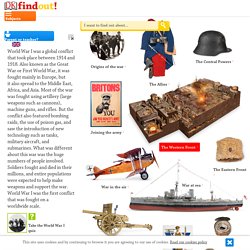
Origins of World War I › World War I Facts. World War 1 for Kids - History Games and Videos. World War 1 for Kids World War I was a large-scale military conflict involving European nations, United States and other nations across the world.

The war lasted from August 4, 1914 to November 11, 1918. More than 15 million people were killed and 20 million people were wounded, making it one of the most devastating conflicts ever. World War I for Kids: Overview. History World War I was a major conflict fought between 1914 and 1918.

Other names for World War I include the First World War, WWI, the War to End All Wars, and the Great War. Who fought in World War I? Never Such Innocence. Welcome Back. Welcome Back. War Animals From Horses to Glowworms: 7 Incredible Facts. Print Cite Article Details:War Animals From Horses to Glowworms: 7 Incredible Facts Author History.com Staff Website Name History.com Year Published 2011 Title War Animals From Horses to Glowworms: 7 Incredible Facts URL Access Date April 21, 2016 Publisher A+E Networks The movie “War Horse,” which follows a cavalry horse through the trenches and turmoil of World War I, opens in U.S. theaters on December 25.

Explore these fascinating facts about the role horses and other animals have played in warfare throughout history, from dogs and elephants to glowworms and dolphins. Animal Heroes of the Great War (Part II): A Courageous Dog... Part one of this column dealt with the recent release of Steven Spielberg’s latest movie, War Horse.
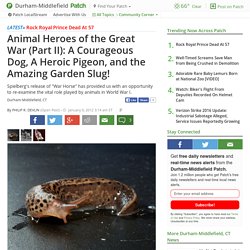
Set in World War I, the movie tells an inspiring tale of love and devotion between man and animal. The movie also serves to remind us of the valuable role that animals played in winning World War I. Besides horses, dogs, pigeons, and even garden slugs played important roles in the war. The most famous animal to emerge from the war had a strong Connecticut connection: Sgt. Stubby, a bulldog terrier with a short, stubby tail. World War I: animals. Animals played an important role in World War I.
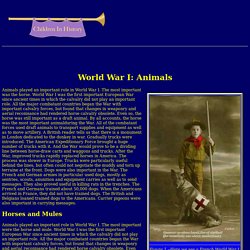
The most important was the horse. World War I was the first important European War since ancient times in which the calvalry did not play an important role. All the major combatant countries began the War with important calvalry forces, but found that changes in weaponry and aerial reconisance had rendered horse calvalry obsolete. Animals in World War One - Animals in WW1 - First World War - Our history. Of the 2.5 million injured animals admitted to the Army Veterinary Corps during the First World War, over 85 per cent were treated and returned to duty.
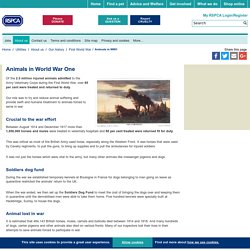
Our role was to try and reduce animal suffering and provide swift and humane treatment to animals forced to serve in war. Crucial to the war effort Between August 1914 and December 1917 more than 1,850,000 horses and mules were treated in veterinary hospitals and 80 per cent treated were returned fit for duty. This was critical as most of the British Army used horse, especially along the Western Front. It was horses that were used by Cavalry regiments, to pull the guns, to bring up supplies and to pull the ambulances for injured soldiers. Amputations/Surgeries in World War 1 by Maddie Held on Prezi. The Legends and Traditions of the Great War: The Red Poppy. Long before the Great War, the red poppy had become a symbol of death, renewal and life.
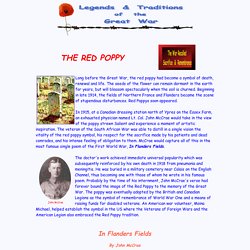
The seeds of the flower can remain dormant in the earth for years, but will blossom spectacularly when the soil is churned. Beginning in late 1914, the fields of Northern France and Flanders became the scene of stupendous disturbances. Red Poppys soon appeared. In 1915, at a Canadian dressing station north of Ypres on the Essex Farm, an exhausted physician named Lt. Col. The doctor's work achieved immediate universal popularity which was subsequently reinforced by his own death in 1918 from pneumonia and meningitis. The Story of the Flanders Fields Remembrance Day Poppy. This is the story of how the red field poppy came to be known as an internationally recognized symbol of Remembrance. From its association with poppies flowering in the spring of 1915 on the battlefields of Belgium, France and Gallipoli this vivid red flower has become synonymous with great loss of life in war. Yet the scope of the poppy and its connection with the memory of those who have died in war has been expanded to help the living too.
It was the inspiration and dedication of two women who promoted this same “Memorial Flower” as the means by which funds could be raised to support those in need of help, most especially servicemen and civilians suffering from physical and mental hardship as a result of war. Colour and Life in a Devastated Landscape. The Royal British Legion. During the First World War (1914–1918) much of the fighting took place in Western Europe. Previously beautiful countryside was blasted, bombed and fought over, again and again.
The landscape swiftly turned to fields of mud: bleak and barren scenes where little or nothing could grow. Bright red Flanders poppies (Papaver rhoeas) however, were delicate but resilient flowers and grew in their thousands, flourishing even in the middle of chaos and destruction. In early May 1915, shortly after losing a friend in Ypres, a Canadian doctor, Lt Col John McCrae was inspired by the sight of poppies to write a now famous poem called 'In Flanders Fields'. McCrae’s poem inspired an American academic, Moina Michael, to make and sell red silk poppies which were brought to England by a French woman, Anna Guérin. The following year, Major George Howson set up the Poppy Factory to employ disabled ex-Servicemen.
The red poppy - Anzac Day. Anzac poppy The red poppy has become a symbol of war remembrance the world over. People in many countries wear the poppy to remember those who died in war or who still serve. In many countries, the poppy is worn around Armistice Day (11 November), but in New Zealand it is most commonly seen around Anzac Day, 25 April. International Encyclopedia of the First World War (WW1) Introduction↑ World War I - National intelligence communities, Sabotage, Communications and cryptology. World War I, which spanned a four-year period between 1914 and 1918, erupted as a result of the complicated European alliance system. The assassination of Austrian Archduke Ferdinand, and his wife, Sophie, by Serbian nationalists sparked pan-European conflict when Russia, backed by France, declared their intent to defend Serbia, should Austria declare war. The Austrian government, with its ally Germany, declared war on Serbia three days later. British forces joined the French and Russians, but the United States, home to large immigrant populations of all of the fighting nations, resolved to remain out of the conflict.
The United States declared its neutrality, but the nation harbored Allied sympathies. United States manufacture and trafficking of munitions and supplies to aid British and French forces angered Germany and Austria. Spies and Espionage in WWI - Home. World War 1 Espionage. The War Underground: An Overview. When war broke out in 1914, no one could have possibly foreseen what the conflict would be really like. At the time, in the common idiom, war was a glorious business, an exciting adventure that offered the chance to become a man, a modern-day knight who would adorn the pages of great books about heroism and the majesty of empire.
Media, as we know it today, simply did not exist. There was no 24-hour news coverage or the steady stream of television images from the front that we are so used to seeing today. The Tunnelling Companies RE of 1914-1918. The war on the Western Front bogged down into siege conditions by November 1914. Both sides faced the need to break through the enemy's defensive entrenched positions. It was not long before an ancient art was remembered and used most effectively: mining under the enemy lines, placing explosives and blowing them up. BBC iWonder - Was the tunnellers’ secret war the most barbaric of WW1? The New Zealand Tunnelling Company - The Arras tunnels. Tunnelling and the First World War. Spying during World War One. Female Spies in World War I and World War II. Updated October 26, 2015. While women are still officially not allowed in combat in almost all nations, there is a long history of female involvement in warfare, even in ancient times.
Espionage knows no gender and in fact being female could provide less suspicion and a better cover. Rebecca’s War Dog of the Week: Red Cross dogs of WWI. By William Treseder Best Defense guest columnist The Republican Party is steadily losing support within the military, its strongest and most steadfast constituent. The extremist elements within the GOP are driving away those who wear or have worn a uniform. Their brinksmanship, anti-government biases, and self-contradictory policies can no longer be hidden by rhetoric, as this shutdown makes clear. Military disassociation with the GOP started during George W. Dogs' WW1 jobs uncovered in records. Image copyright PA Up to 20,000 dogs were trained for front-line duties during World War One, newly uncovered records have shown.
Buddies: Soldiers and Animals in World War II. Fall 1996, Vol. 28, No. 3. The Unsung Heroes Who Had No Choice: The War Horses of WWI. The Forgotten Army. The Role of Animals in World War I. HorsesA4. Transport And Supply During The First World War. BBC Schools - Transporters. How did animals (even slugs) serve in World War I? 15 Animals That Went To War. Honoured: the WW1 pigeons who earned their wings. Carrier Pigeons Used During World War I. WW100 New Zealand. Pigeons and World War One. Battlefield Medics: Saving Lives Under Fire. Royal Army Medical Corps in the First World War - The Long, Long Trail. RAMC - The Royal Army Medical Corps in WW1. National World War I Museum and Memorial. The Great War . Timeline . Pre-1914.
WW1 Timeline - A detailed history of the Great War 1914-1918. New Zealand and the First World War - First World War - overview. A Multimedia History of World War One. History - Historic Figures: General Douglas Haig (1861 - 1928) General Douglas Haig.
Gallipoli. Facts for students - FTfs. BBC Bitesize - What was it like in a World War One trench? Continuations and Beginnings. BBC Schools - WW1 Primary. BBC Schools - Illness and injury. BBC iWonder - How did Britain let 250,000 underage soldiers fight in WW1? BBC Schools - Treating soldiers. Wounding in World War One.